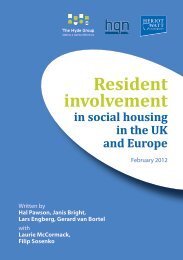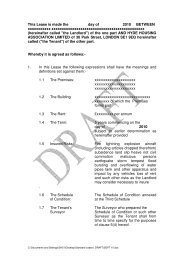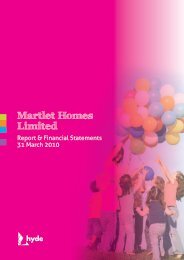Retrofit & Replicate - Hyde Housing Association
Retrofit & Replicate - Hyde Housing Association
Retrofit & Replicate - Hyde Housing Association
Create successful ePaper yourself
Turn your PDF publications into a flip-book with our unique Google optimized e-Paper software.
With these measures in place, the space<br />
heating requirements at the property are<br />
estimated to reduce from 17,238 kWh/yr to<br />
2,410 kWh/yr – a drop of over 86%. With such<br />
low levels of heating required, tenant fuel<br />
bills will be significantly reduced. Capital cost,<br />
ease of retrofitting and ongoing maintenance<br />
requirements therefore become the most<br />
important driver in the choice of fuel source.<br />
Ground source heat pumps are relatively<br />
expensive to install and need to be located<br />
in a substantial, and preferably soundproofed,<br />
cupboard. Furthermore, to operate<br />
efficiently they work best in conjunction with an<br />
underfloor heating system, which in itself has<br />
inherent problems in a retrofit situation.<br />
The feasibility for underfloor heating was<br />
explored by ECD and Mears and found to be<br />
technically possible but only with a reduction<br />
in underfloor insulation levels and an increase<br />
in installation time and cost. When further<br />
confronted with a solid concrete floor in the<br />
kitchen, the concept was rejected in favour of a<br />
conventional wet radiator system. Heat pumps<br />
require electricity to operate, which in the UK is<br />
particularly carbon intensive – more than twice<br />
the kgCO 2<br />
/kWh than mains gas. Therefore to<br />
produce carbon reductions in comparison with<br />
an efficient gas condensing boiler, heat pumps<br />
need to achieve a Coefficient of Performance<br />
greater than 2.5 measured across the whole<br />
year – the recent trials at the Barratt EcoSmart<br />
show properties recorded a CoP of 2.6. Air<br />
source heat pumps are unlikely to improve<br />
upon these results at present and would also<br />
require underfloor heating. A biomass boiler<br />
was also ruled out by <strong>Hyde</strong> as it was thought<br />
to place an undue burden on the tenant to<br />
source and store a supply of wood pellets,<br />
and would again require additional plant<br />
space. With these considerations in mind, the<br />
decision was made to upgrade the existing<br />
gas boiler for a more efficient condensing unit<br />
and the Vaillant ecoTEC system was selected,<br />
with low NOx emissions and programmable<br />
controls. This was relocated to a hall<br />
cupboard since the existing flue outlet position<br />
contravened modern guidelines.<br />
The gas condensing boiler will also supply hot<br />
water to the property but will be supplemented<br />
by solar thermal collectors located on the<br />
pitched roof. The system is to be supplied<br />
and installed by Kingspan Renewables in<br />
conjunction with a twin-coil 250l Range Tribune<br />
thermal store located in the loft space. Two<br />
flat plate collectors mounted either side of<br />
the ridge will face east and west but will be<br />
controlled intelligently to favour the better<br />
performing panel as the sun tracks around<br />
the house to the south. It is hoped that 50-<br />
60% of the tenant’s hot water needs will be<br />
met by this system. All connecting pipework<br />
between boiler and thermal store will be well<br />
insulated to prevent heat transfer to the internal<br />
environment.<br />
A significant proportion of the property’s<br />
electricity load will be for lighting therefore<br />
the retrofit proposals will seek to minimise<br />
this component. Other major demands for<br />
electricity, eg for household appliance and<br />
entertainment use, are typically beyond the<br />
control of any RSL refurbishment scheme<br />
and down to tenant behaviour. The ‘<strong>Retrofit</strong><br />
and <strong>Replicate</strong>’ exemplar project therefore<br />
concentrates on minimising electrical lighting<br />
loads through the installation of low energy<br />
lighting to every room. However, unlike<br />
typical low energy lighting solutions, the use<br />
of compact fluorescents will be avoided in<br />
favour of the latest in LED technology. Unlike<br />
CFLs, LED lamps contain no contaminants<br />
such as mercury or phosphor and can be<br />
safely disposed of or recycled. Although they<br />
are much more expensive currently, they<br />
are very robust and offer 50,000 hours of<br />
use (compared to 10,000 for CFLs or 3,000<br />
for halogens) meaning no need to change<br />
then for at least 20 years! In this way, energy<br />
use is significantly reduced without the<br />
customary start-up delays and only a small<br />
reduction in efficacy. ECD have worked with<br />
Gloucestershire-based specialist GreenLED<br />
to develop the layouts and specifications.<br />
GreenLED will supply 3.7W Antares GU10<br />
lamps for installation by Mears into standard<br />
recessed fittings.<br />
- 4 -

















